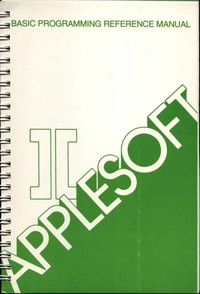Apple II: Applesoft Basic Programming Reference Manual
| Home > Browse Our Collection > Manuals > Apple II Manuals > Apple II: Applesoft B ... ming Reference Manual |
|
Apple II Applesoft Basic Programming Reference Manual
APPLESOFT II BASIC is APPLE'S very much extended BASIC language. BASIC has been extended because there are many features on the APPLE II computer that just aren't available on other computers that use BASIC. By adding a few new words to the BASIC language, these features are Immediately available to anyone using APPLESOFT. Among the features supported by APPLESOFT are apple's color graphics, high-resolution color graphics and the direct analog inputs (the game controllers).
Another feature of APPLESOFT is this manual. It is not a self-teaching manual, since APPLE provides a separate manual (the APPLE II BASIC Programming Manual ) which will help you learn to program even if you have never touched a computer before. This manual assumes that you know how to program in BASIC and just wish to learn the additional features offered by APPLESOFT. Chapter 1 (GETTING STARTED) is a quick run-through of what the language has to offer. The rest of the manual is a careful and exact description of every statement in the language and how each statement works. This reference manual assumes you have a minimal working knowledge of the programming language BASIC. If you're unfamiliar with BASIC, the APPLE II BASIC Programming Manual can provide an introduction: it covers a version of BASIC which is much like APPLESOFT II, but simpler. CHAPTER 3 SYSTEM AND UTILITY COMMANDS CHAPTER 4 EDITING AND FORMAT- RELATED COMMANDS CHAPTER 5 ARRAYS AND STRINGS CHAPTER 6 INPUT/OUTPUT COMMANDS CHAPTER 7 COMMANDS RELATING TO FLOW OF CONTROL CHAPTER 8 GRAPHICS AND GAME CONTROLS CHAPTER 9 HIGH-RESOLUTION SHAPES CHAPTER 10 SOME MATH FUNCTIONS Appendix A Getting APPLESOFT BASIC up Platform: Apple II, II Plus with 48Kb RAM Disk 5.25 drive OS: DOS System Software (SS:) Programming Language (PL:) BASIC Version: 1978
This exhibit has a reference ID of CH1740. Please quote this reference ID in any communication with the Centre for Computing History. |
Click on the Images For Detail
|










